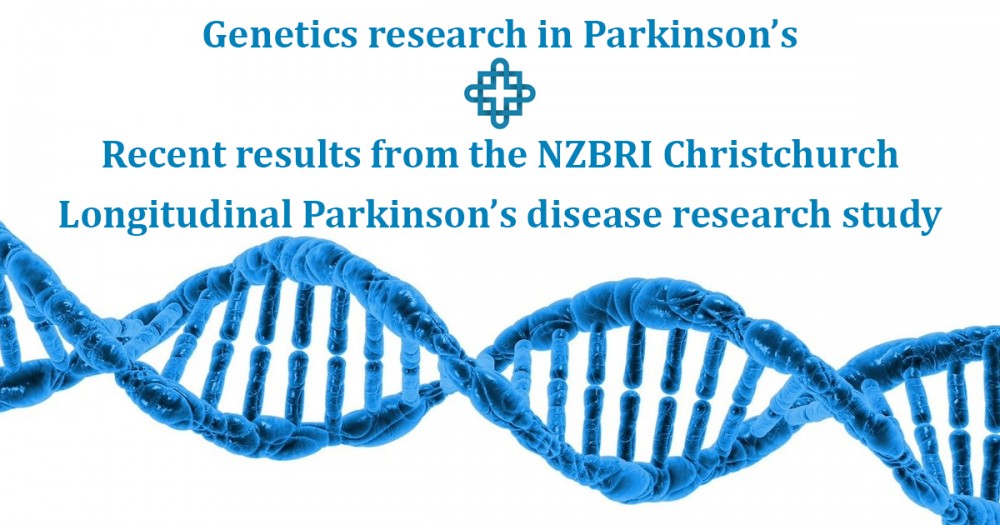Genetics Research in Parkinson’s
May 2020
It used to be thought that genes had no role in Parkinson’s, but this notion is changing. The research community is still learning about how our DNA and changes within it contribute to our risk of developing Parkinson’s. At NZBRI, we have been collecting DNA from research participants since 2012, and now have samples from more than 300 people with Parkinson’s and approximately 60 control participants. We work closely with local geneticist Prof. Martin Kennedy and his team to make sure these DNA samples are contributing to the advancement of our knowledge of the genetics of Parkinson’s.
What we know about genes in Parkinson’s
A small proportion (roughly 10%) of Parkinson’s cases are considered to be familial - this means they arise from sequence variations (referred to as mutations) in specific genes. The remaining 90% of cases are considered sporadic or of unknown cause. The current thinking is that these sporadic cases are due to a combination of both genetic and environmental factors (anything not genetic). In these cases, the sequence variations increase risk of a person developing Parkinson’s, but by themselves are not sufficient to cause the disorder. These risk variations are not consistently passed on to subsequent generations. Overall, it is likely that a person with Parkinson’s has more than one genetic risk factor and is exposed to more than one environmental risk factor.
Genetic investigations are generally not carried out as part of the standard clinical assessment of Parkinson’s. At this stage, there is little clinical value to knowing an individual’s genetic risk of Parkinson’s because it is not possible to target treatment based on the genetics of an individual.
GBA
Sequence variations in a gene known as GBA are some of the most commonly-occurring ones known to increase the risk of Parkinson’s. Recent work by PhD student, Oscar Graham, has established that in our local people with Parkinson’s, 9.3% possess one or more variations within this gene (published Jan 2020 in Parkinsonism & Related Disorders). This rate is similar to international studies of predominantly European populations. The GBA gene can be technically difficult to study in the lab. Part of Oscar’s challenge was perfecting methods and validating them, to ensure the actual gene was being sequenced.
The results of Oscar’s GBA work have also contributed significantly to a research paper (currently under review) produced by Assoc. Prof. Justin O’Sullivan and his team from the University of Auckland. This study proposes that the GBA gene may not only increase risk through specific changes in its DNA sequence, but also via interactions with other genes. Oscar’s data was able to provide key observations that support their theory. This work identified a network of genes that interact with GBA and may provide new clues to the biology and genetic factors underlying Parkinson’s.
Why is GBA so important?
The GBA gene provides the blueprint for forming beta-glucocerebrosidase, which acts as a ‘housekeeping’ enzyme, helping to break down molecules not needed by the cell. There is some evidence that activity of this enzyme is decreased in all people with Parkinson’s (even in the absence of sequence variations) and that interactions between it and alpha-synuclein (a protein that builds up in the brain in Parkinson’s) may be important in the development of the disorder. There is quite a lot of research underway seeking treatments that might alter the activity of the beta-glucocerebrosidase enzyme and thereby slow down the course of Parkinson’s.
Other genetic research
As our understanding of the genetics has increased so has our appreciation for the need to have large-sized patient groups to obtain scientifically reliable results. In light of this, we have joined two international study groups to help advance our knowledge of how genes contribute to Parkinson’s.
Firstly, we are members of the Systems Genomics of Parkinson’s disease (SGPD) study group, which includes researchers from Australia. In March 2020, it published a major paper in Nature Communications, looking not only at the genes but also the epigenome. The epigenome refers to an array of chemical changes in the DNA and proteins that form our chromosomes, and in this paper modifications to the DNA, called “methylation”, were studied. These molecular changes help to control which genes are expressed in each cell type (e.g. why skin cells are different to brain cells). Unlike the underlying DNA sequence, the epigenome changes in response to our experiences throughout our lifetime. It is widely thought that changes in the epigenome are likely to be part of the pathway whereby environmental exposures interact with and influence genes. The SGPD paper identified changes in the epigenome that were associated with a diagnosis of Parkinson’s. These changes appear to affect a specific gene called SLC7A11 that transports substances between cells and helps to control oxidative stress. Oxidative stress is a process that occurs during metabolism and can damage cells. A decrease in the activity of this gene potentially leads to increased oxidative stress on cells, making them more vulnerable to damage.
Secondly, we have joined the ENIGMA (Enhancing Neuro Imaging Genetics through Meta Analyses) study group. This consortium aims to combine high tech genetic data with brain imaging data from a very large number of people, in order to understand the wide array of genetic factors that influence brain development and structure. DNA data collected by NZBRI contributed a paper published in March 2020, in the very prestigious journal Science. In this enormous study of over 50,000 individuals, some 300 genetic sites were identified that influence the surface area and thickness of the cortex, the outside layer of the brain. Some of these regions of the genome may also be relevant to the risk of Parkinson’s, and this paper will stimulate a great deal of further research in this area.
Again, we’d like to thank all our research participants for their contribution to our Parkinson’s research. As you can see, the discoveries and collaborations worldwide are significant and we can’t do this without you.

